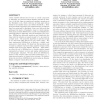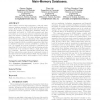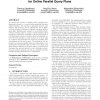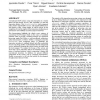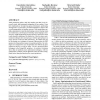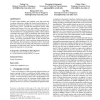SIGMOD
2012
ACM
12 years 8 months ago
2012
ACM
We present an automatic skew mitigation approach for userdefined MapReduce programs and present SkewTune, a system that implements this approach as a drop-in replacement for an e...
SIGMOD
2012
ACM
12 years 8 months ago
2012
ACM
Cloud enabled systems have become a crucial component to efficiently process and analyze massive amounts of data. One of the key data processing and analysis operations is the Sim...
SIGMOD
2012
ACM
12 years 8 months ago
2012
ACM
There exists a need for high performance, read-only mainmemory database systems for OLAP-style application scenarios. Most of the existing works in this area are centered around t...
SIGMOD
2011
ACM
13 years 8 months ago
2011
ACM
We address the problem of making online, parallel query plans fault-tolerant: i.e., provide intra-query fault-tolerance without blocking. We develop an approach that not only achi...
SIGMOD
2011
ACM
13 years 8 months ago
2011
ACM
Probabilistic database systems have successfully established themselves as a tool for managing uncertain data. However, much of the research in this area has focused on efficient...
SIGMOD
2011
ACM
13 years 8 months ago
2011
ACM
Conventional OLTP systems assign each transaction to a worker thread and that thread accesses data, depending on what the transaction dictates. This thread-to-transaction work ass...
SIGMOD
2011
ACM
13 years 8 months ago
2011
ACM
Over the last decade the cost of producing genomic sequences has dropped dramatically due to the current so called “next-gen” sequencing methods. However, these next-gen seque...
SIGMOD
2011
ACM
13 years 8 months ago
2011
ACM
Ranking queries report the top-K results according to a user-defined scoring function. A widely used scoring function is the weighted summation of multiple scores. Often times, u...
SIGMOD
2011
ACM
13 years 8 months ago
2011
ACM
Table partitioning splits a table into smaller parts that can be accessed, stored, and maintained independent of one another. From their traditional use in improving query perform...
SIGMOD
2011
ACM
13 years 8 months ago
2011
ACM
To achieve high reliability and scalability, most large-scale data warehouse systems have adopted the cluster-based architecture. In this paper, we propose the design of a new clu...

